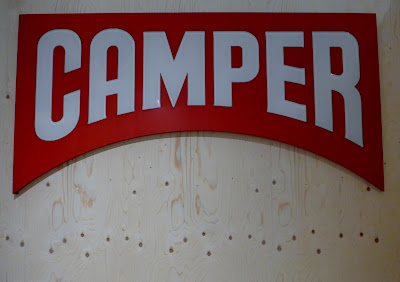Life on Foot, the exhibition of Camper's story of shoe making is on at the Design Museum.
Lorenzo Fluxa founded Camper after inheriting his father's shoe factory in Mallorca in 1975, introducing the camper logo, the Red Bridge, in 1981 with his first store in Barcelona.
Camper has been around for 40 years and despite spending my sixth-form weekends working in a shoe shop, Manfield in Chesham High Street, I had never heard of them until five or six years ago. That's when I bought a pair of their slippers, which are still going strong. I love those slippers.
Rainbows of camper shoes and materials.
Camper produces sustainable and ethical footwear. The first camper shoes experimented with used recycled car tyres for soles.
These shoes below are fully bio-degradable, experimenting with hemp and coconut. "Those grey ones on the right look a little like my slippers."
I applaud their commitment to sustainable materials, but can see that wearing cork is perhaps a little more suitable to the Spanish climate than ours.
In an average collection of Camper shoes, over 350 materials are used, components that remind me of "Ink Blots". I can't help myself looking for things in the shapes and checking to see if the patterns are symmetrical.
The shoe box, "a basic yet important part of footwear manufacture and retailing". Too right. What is so appealing about a brand new shoe box? It's not as if we keep them (for long).
However good packaging has always been so appealing. It's strange though, with the power of packaging to tempt us to purchase, you generally get to see a shoebox after you have decided to buy the shoes. "Do you want the Box?" I always asked as a teenager in Manfield. Now the shoe's on the other foot (sorry), I get asked this when I buy my kids shoes. Of course they want the box, a new home for a toy hamster, a lunar landscape, a treasure chest, the possibilities are endless and made even more appealing by boxes like these.
From this archive material we can see that it wasn't just about the shoe and manufacturing, but Camper's concepts extended to the designs of packaging and visual merchandising too.
Camper regularly collaborates with graphic designers,
...and store designers.
Camper regularly collaborates with graphic designers,
...and store designers.
White moulded shoes from the wall of a Camper store in new York, 2014.
Life on Foot is on at the Design Museum until 1st November 2015.
Details on their website here.
What ever happened to Manfield?












































